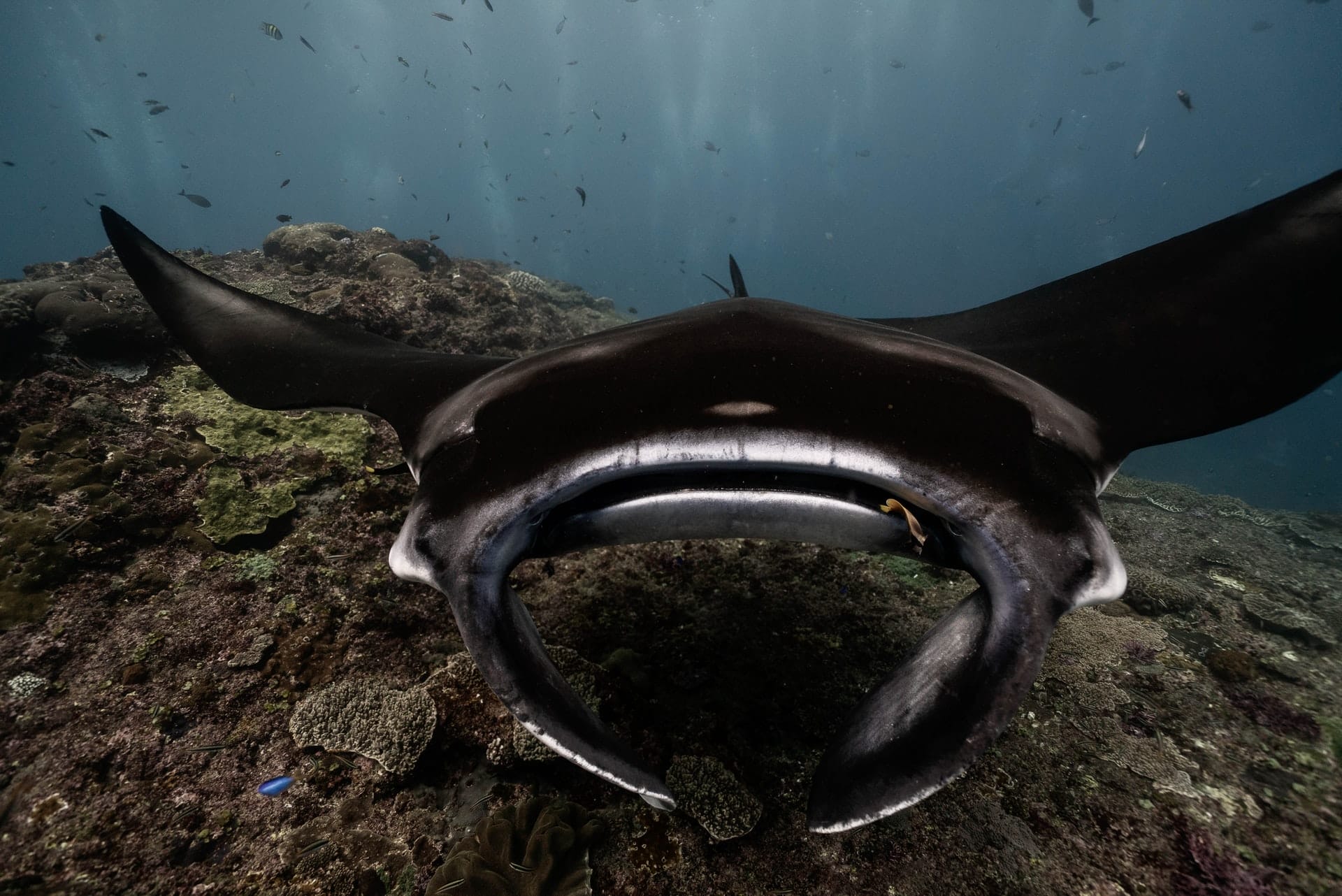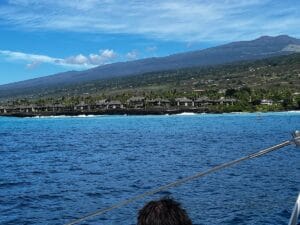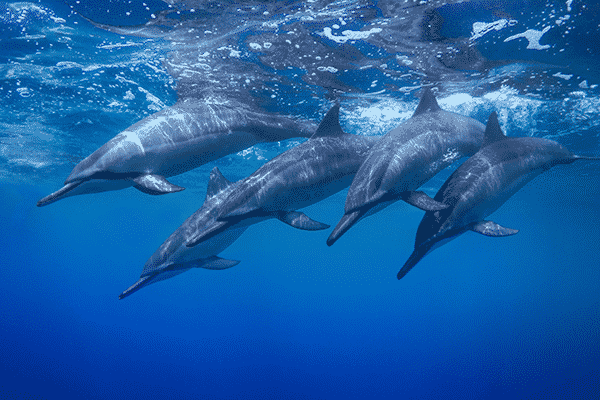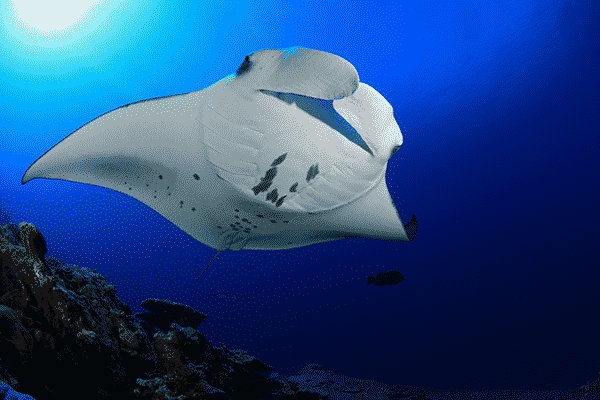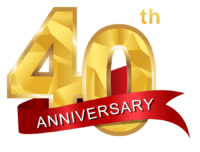Our manta ray tours are one of the best on the Big Island to view these beautiful animals in their own environment.
Hannah Ward reports on the biggest manta ray ever for A-Z Animals.
Of all the fish in the sea, manta rays have got to be amongst the most graceful and breathtaking creatures. With a diamond-shaped appearance and huge fins that look like wings, manta rays glide through the water with an ease that belies their size. Also known as birds of the sea, these huge fish have an average wingspan of 23 feet and a weight of about 4,500 pounds. Not only that, but manta rays actually have the largest brains out of all the fish in the world.
But just how big can manta rays get? We’ll dive into the largest manta ray ever recorded and what size ancient manta rays may have reached!
The Background on Manta Rays
As well as their distinctive shape and massive wings, manta rays can easily be distinguished by their wide mouths and “horns” that are actually called cephalic fins or lobes and are used for channeling water and food into their mouths while they are feeding. There are two species of manta ray: the reef manta ray (manta alfredi) and the giant manta ray (manta birostris). The giant manta ray is the larger of the two. Both species have the typical manta ray coloring of black on their back and white on their bellies but giant manta rays have black mouths while reef manta rays have white mouths. Although these huge rays are often mistaken for stingrays, they don’t have a barb on their tail and so can’t sting. In fact, manta rays are actually extremely gentle and friendly creatures that are not harmful at all.
Manta rays are usually found in tropical and subtropical waters and are migratory animals that largely follow where the food is. Reef manta rays are mainly found in the Indo-Pacific ocean while the giant manta rays frequent the seas all the way around the equator. Ecuador currently has the largest individual population of manta rays with around 650 having been identified there. In deeper waters, manta rays have often been seen diving to depths of around 2,000 feet, but have been known to go much deeper on occasions, with their powerful wings propelling them through the water.
The Largest Manta Ray Ever Recorded
Although manta rays have an average wingspan of 23 feet, the largest manta ray ever recorded was much larger and reached a whopping 30 feet. Recorded in 1920, this huge manta ray even made it into the Guinness World Records as the largest manta ray ever recorded. No weight was recorded for this record breaker, but the heaviest manta ray recorded was a female in 1933 who weighed in at around 5,000 pounds.
Despite her super-sized weight, the female giant manta ray only reached a relatively small 20 foot wingspan. Caught by Captain Khan, a New York silk merchant, in 1933 off the coast of New Jersey, the massive manta ray became tangled in the anchor line of his boat while he was fishing and towed him five miles over three hours while he feared his boat would capsize.
Were Ancient Rays Even Larger?
Many of the largest species today had relatives that actually dwarfed them. For example, while the largest sea turtle today weighed up to 2,019 pounds, ancient sea turtles weighed 2.5 times as much! The largest great white shark ever recorded weighs about 5,000 pounds, but Megalodon may have weighed 20 to 50 times more!
So, were ancient manta rays giants that could reach 50 feet across? While rays have been around since the Jurassic Period (150 million years ago), there’s no evidence of past rays that are larger than today’s giants. This means today’s giant oceanic manta rays could be the largest species to ever swim in the world’s oceans!
Interesting, about 95 million years ago there was a species known as the “eagle shark” that combined aspects of sharks and rays. The unique prehistoric fish has long wings like a ray, but the body of a shark. However, compared to today’s giant manta rays it would be quite small, measuring only 6 feet long.
How do Manta Rays Compare with other Fish?
It is already pretty impressive for manta rays to reach the size that they are without being predatory animals and by eating only some of the smallest food that the ocean can provide, but how do they compare with other fish in the sea?
Manta rays are the fifth largest fish in the sea, behind only basking sharks, whale sharks, great white sharks,
and tiger sharks – the largest of which is the whale shark with a length of around 60 feet. Manta rays are also the biggest of all animals in the order Batoidea which includes stingrays, manta rays, and skates. With the largest species of stingray having an average wingspan of only five feet, manta rays dwarf them.
There are a few other species of fish – such as the Beluga sturgeon with a length of 24 feet, and the ocean sunfish with a weight of around 4,300 pounds – that come close to the manta ray in size but are still smaller, meaning the manta ray maintains its position as one of the largest fish in the world.
How do Manta Rays Get So Big?
All manta rays are filter feeders and they eat plankton and shrimp and other small organisms. Manta rays have a unique way of feeding as they hold their cephalic fins in an “O” shape to help push water and food into their open mouth. Once they have taken in a mouthful of water and plankton they push it over their gill rakers which are like a giant filter to separate out the food and push the water back out. They often even do great barrel roles while they are feeding to help them take in more food with each mouthful.
As manta rays are so massive they have very few natural predators other than some of the largest sharks and killer whales. Despite their large size, they can actually move pretty fast and have a top speed of 15mph which helps them get away from predators. However, their main threat actually comes from us humans as they are often caught up in fishing nets as bycatch. While there is little data available on total population, both species of manta ray are officially classed as being in danger, with the giant manta ray classed as endangered and the reef manta ray classed as vulnerable on the IUCN red list.

